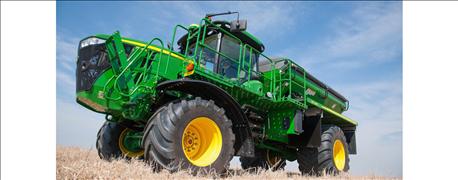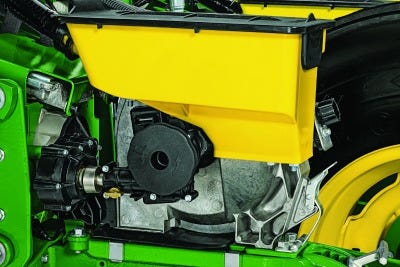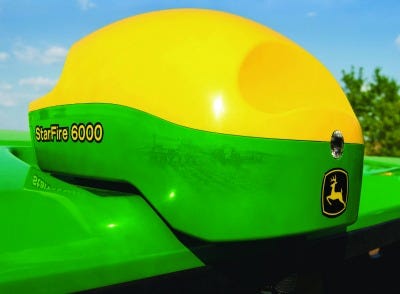June 8, 2016

Ahead of the fall show season, John Deere has rolled out six major new products ranging from a high capacity nutrient applicator to a new electric planter meter. Here's a rundown of the new tools some available this year and more for 2017 as indicated.
High-tech fertilizer spreader
John Deere is getting into the dry fertilizer and lime application business in a big way. The company has long offered a dry-box option for its spray rigs, but this new machine - the F4365 High Capacity Nutrient Applicator offers new features from the company.

BIG DRY APPLICATOR: John Deere teased this machine at a product introduction in the Fall of 2015, and now announces it's ready for market. The machine builds on the company's application business.
The new machine has a 330-cubic-foot New Leader dry spinner spreader that can apply fertilizer at rates up to 1,100 pounds per acre and lime at rates up to 6,600 pounds per acre. The machine can also offer variable rate application of up to four different products during a single pass, with spreader widths from 60 to 90 feet.
Power for the new machine comes from a John Deere PowerTech PSS 9-liter engine with an IVT transmission - the company's version of the continuously variable transmission that is popular on larger tractors in the company line. The applicator includes plenty of tech including a new Generation 4 CommandCenter display with SpreadStar, AutoTrac and Section Control.
For managing a fleet of these machines, JDLink connect with Service Adviser Remote and Wireless Data Transfer are standard. AgLogic is available to optimize the machine with the tendering fleet and maximize productivity. AgLogic is a logistics software package that many elevators use to make sure their machines keep moving because they're tendered efficiently.

GOING ELECTRIC: The new MaxEmerge 5e row units, available for 2017, will allow John Deere planter owners the opportunity to update a range of machines with that latest planting technology.
Operators will have plenty of room since they're riding in a CommandView III cab. And moving from field to field is efficient with a 46 mph road speed, and up to a 30 mph application speed.
Expanding electric planter meter choices
John Deere is rolling out the new MaxEmerge 5e row units - with e standing for 'electric.' The units will be available for use in spring 2017 and offer variable-rate planting. The units will fit on a wide variety of John Deere planters including the mini-hopper and DB machines.
In a press statement announcing the new machines, Brian Boelens, product specialist, John Deere Seeding, notes that the units will boost seeding accuracy across the full width of the planter, especially when operating on curves. " With planters equipped with the electric meter drive for each row unit and related technology, customers can achieve up to a 20% improvement in population accuracy and eliminate a potential one to two percent yield loss due to seeding inaccuracies," he says.

BOOSTING STARFIRE: The New StarFire 6000 receiver has enhanced technology to provide even higher accuracy in a greater range of conditions.
The units will still use a seed tube, but the electric drive meter on each row unit replaces traditional shafts and drivelines, allowing each row unit to work independently. The MaxEmerge 5e row unites can be used on the following machines: 1725 16-row, 1775NT, 1795, DB44, DB60, DB66, DB80, DB88, and DB90 planters, including mini-hopper, 1.6-bushel and 3-bushel hopper models. It is compatible with SeedStar 3HP and SeedStar Mobile seed monitoring systems that have a wireless data server.
Standard features include variable rate, individual row electric meter drives; SeedStar 3HP monitoring system; one year free activation of SeedStar Mobile; Curve Compensation; vacuum automation; meter runoff and built in RowCommand. To operate the electric drive meters, tractors need to have a PTO for electric power generation.
“For customers running newer model planters, retro fit kits are available to convert to MaxEmerge 5e units which will improve seeding accuracy while increasing productivity and uptime,” Boelens adds. “With today’s tight margins, corn and soybean producers are looking for ways to maximize yields and productivity while saving time and input costs. Planting with a MaxEmerge 5e row unit equipped planter can help them achieve those goals.”
New StarFire receiver
John Deere is upping the ante in GPS receivers with the new StarFire 6000 receiver and SF3 signal. According to Mike Moeller, John Deere Intelligent Solutions Group, the receiver is designed to give you improved precision capabilities. In the announcement for the new machine, Moeller explains that "the StarFire 6000 Receiver offers a full range of differential correction levels, from the base SF1 satellite-delivered signal to the premium RTK option. And to optimize the performance of the [receiver] we're offering the all-new SF3 correction level."
In the announcement, Moeller explains that the new correction level offers 40% greater pass-to-pass accuracy, new in-season repeatability and 66% faster pull-in time than the previous SF2 correction level. That will speed up your start when entering a field.
Adds Moeller: "StarFire 6000 with SF3 is a great solution when RTK is not available and customers want in-season repeatable accuracy to 1.2 inches. SF3 customers can use the same guidance lines for multiple passes throughout the growing season which allows precise placement of seed and nutrients without shifting lines or remapping boundaries."
To boost uptime, the StarFire 6000 can track up to three StarFire satellite signals at once and choose the one that will deliver the best performance, and switch to an alternate signal to help maintain accuracy and performance if the primary signal is blocked.
Enhancing sprayer accuracy
John Deere is rolling out two new AutoTrac products for improved spraying accuracy. The first - AutoTrac Vision - we actually saw and shared from Agritechnica last fall, but now it's officially coming to the United States. The second, AutoTrac RowSense is new, and we'll tell you more in the next slide.
First up is the AutoTrac Vision, shown, which is a single-lens camera to detect crop rows and help steer the sprayer down the center of the row for early postemergence applications. This camera does work in tandem with the row sensing unit and it's designed to help you cover more acres more quickly with your John Deere sprayer.
In the product announcement, Doug Felter, product marketing manager, John Deere, notes the two new products are designed to help large-scale row-crop producers and ag service providers work more quickly, cover more acres and reduce run-over damage to crops when spraying.
Felter explains: " Because of field terrain, planter drift, or irregular planting without guidance, spraying in row crops can present challenges for sprayer operators making post emerge applications. These two new guidance applications help sprayers track more accurately between the rows, resulting in reduced crop damage, less operator fatigue and more effective field applications."
AutoTrac Vision uses a monocular camera mounted on the front of the sprayer to detect crop rows and steer the vehicle between the rows. It is currently approved for use in corn, soybeans and cotton planted in 30-inch rows starting when the crop is 6-inches tall. It can be used until there is at least 3 inches of soil showing between the rows or up to 90% canopy closure.
The AutoTrac RowSense is a sensor paddle on the sprayer wheel to detect crop rows and help steer the machine down the center of the row. Designed to be used later in the growing season, this unit is approved for corn at least 4-feete tall planted in 30-inche rows.
Felter explains that each system is separate and can be used one at a time, but both have performed in a range of crops and conditions.
Both systems are available as field-installed kits on currently running machines or from the factory on new John Deere R4023, R4030, and R4045 sprayers. A GS3 AutoTrac RowSense activation is required.
A bigger hoe drill
Productivity at planting time is crucial these days as the best weather days seem to be spacing out each spring. Small grains and oil seed producers get a little help with the rollout of a 76-foot 1870 Air Hoe Drill from John Deere. This is the latest addition to the 1870 Air Seeder lineup, which already includes 40- and 56-foot models.
John Peters, marketing manager for the John Deere Seeding Group, notes the wider air seeder integrates a range of features including precision placement, depth and pressure control and other enhancements. "The new 76 foot model 1870 offers a time saving 36% increase in seeding width, better residue flow capabilities, and improved seeding and fertilizer placement and control," he says.
New retractable openers offer easier servicing and improved transport for higher productivity. Combined with a John Deere air cart and used on rolling, undulating terrain, "this is one of the most accurate, productive air seeding systems available," Peters adds.
The 76-foot 1870 is a five-section seeder with 12-inch row spacing compatible with the 430-bushe tow-between and 430- or 550-bushel tow-behind John Deere seed carts. It has a taller frame and 56 inches of spacing between each rank, which is nearly 20 inches more space compared to other seeders to help move residue through with little clogging.
The 1910 Air Carts have been updated to add even more productivity to the 1870 Air Seeder system. They feature a new AirPower 2 Dual fan option that delivers up to 550 pounds of total product per acre across the full width of the air seeder, using two independently controlled fans.
The new air seeder has a floating front hitch and wings with a range of 25 degrees of flex. High-flotation tire s inside the high clearance frame are standard. An exclusive standard feature is TruSet depth and pressure control which lets the operator, set and adjust trip force and packing pressure from the tractor cab. TruSet also makes side-to-side frame leveling easier. It is controlled through the GreenStar 2630 display.
The drill also has Relative Flow blockage monitoring to check the relative flow rate for both seed and fertilizer from the cab.
Walker combine redux
John Deere still markets a walker combine - the T670 - which gets an upgrade for 2017. The machine will have a range of enhancements to boost productivity, threshing capacity and straw quality for baling. The walker combine offers U.S. and Canadian small grain producers productivity and efficiency.
Terry DeMay, senior marketing representative for John Deere Harvester Works, the updated T670 combine has one of the largest active separation areas and largest cleaning shoe of any walker combine on the market today. "We've increased productivity by 15% in wheat and increased loading rates by 50%. We've also made it easier to switch between small grains and canola, and improved the service points to allow producers to spend more time harvesting and less time waiting," he says.
The T670 has a new swing-in Booster Bar which makes switching between small grains and canola easier, and faster - often in less than 5 minutes. And it's easier to adjust as crop conditions change. In addition, John Deere has boosted the size of the overshot beater, concaves, separator drum and grate, and walker area as part of its updated T-concept solution.
With greater throughput and capacity, that means operators need faster unload speeds. The T670 has the Xtra Fast System and can offload grain at 3.3 bushels per second. To make servicing and cleanout more convenient, the new T-series comes with an optional factory-installed 16-gallon air compressor with 33-foot hose and three quick-coupler points to access different areas of the machine.
Source: John Deere
You May Also Like




